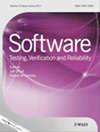部分FSM模型的有效灰盒测试
IF 1.2
4区 计算机科学
Q3 COMPUTER SCIENCE, SOFTWARE ENGINEERING
引用次数: 2
摘要
对于部分不确定性有限状态机,提出了一种新的一致性关系,称为强约简。它补充了其他现有的一致性关系,因为新关系非常适合基于模型的系统测试,这些系统的输入是启用的还是禁用的,取决于实际的系统状态。这种系统的例子是图形用户界面和具有可以以机械方式启用或禁用的界面的系统。我们提出了一种新的测试生成算法,用于生成完整的测试套件。套件是根据灰盒测试范式执行的:假设在测试执行期间可以识别启用输入的状态依赖集,而实现状态保持隐藏,就像在黑盒测试中一样。我们表明,生成算法以这样一种方式利用了这些灰盒信息,从而得到的最佳情况测试套件大小在参考模型的状态空间大小中仅是线性的。此外,实例表明,与真正的黑盒测试相比,这可能导致测试套件大小的显著减少。本文章由计算机程序翻译,如有差异,请以英文原文为准。
Effective grey‐box testing with partial FSM models
For partial, nondeterministic, finite state machines, a new conformance relation called strong reduction is presented. It complements other existing conformance relations in the sense that the new relation is well suited for model‐based testing of systems whose inputs are enabled or disabled, depending on the actual system state. Examples of such systems are graphical user interfaces and systems with interfaces that can be enabled or disabled in a mechanical way. We present a new test generation algorithm producing complete test suites for strong reduction. The suites are executed according to the grey‐box testing paradigm: it is assumed that the state‐dependent sets of enabled inputs can be identified during test execution, while the implementation states remain hidden, as in black‐box testing. We show that this grey‐box information is exploited by the generation algorithm in such a way that the resulting best‐case test suite size is only linear in the state space size of the reference model. Moreover, examples show that this may lead to significant reductions of test suite size in comparison to true black‐box testing for strong reduction.
求助全文
通过发布文献求助,成功后即可免费获取论文全文。
去求助
来源期刊

Software Testing Verification & Reliability
工程技术-计算机:软件工程
CiteScore
3.70
自引率
0.00%
发文量
34
审稿时长
>12 weeks
期刊介绍:
The journal is the premier outlet for research results on the subjects of testing, verification and reliability. Readers will find useful research on issues pertaining to building better software and evaluating it.
The journal is unique in its emphasis on theoretical foundations and applications to real-world software development. The balance of theory, empirical work, and practical applications provide readers with better techniques for testing, verifying and improving the reliability of software.
The journal targets researchers, practitioners, educators and students that have a vested interest in results generated by high-quality testing, verification and reliability modeling and evaluation of software. Topics of special interest include, but are not limited to:
-New criteria for software testing and verification
-Application of existing software testing and verification techniques to new types of software, including web applications, web services, embedded software, aspect-oriented software, and software architectures
-Model based testing
-Formal verification techniques such as model-checking
-Comparison of testing and verification techniques
-Measurement of and metrics for testing, verification and reliability
-Industrial experience with cutting edge techniques
-Descriptions and evaluations of commercial and open-source software testing tools
-Reliability modeling, measurement and application
-Testing and verification of software security
-Automated test data generation
-Process issues and methods
-Non-functional testing
 求助内容:
求助内容: 应助结果提醒方式:
应助结果提醒方式:


